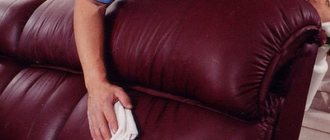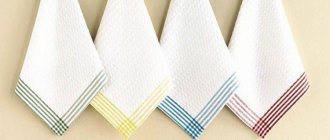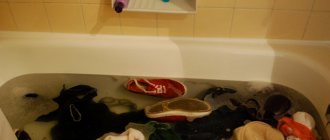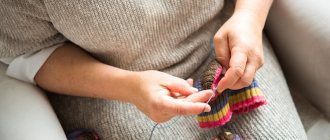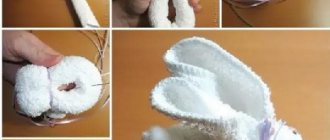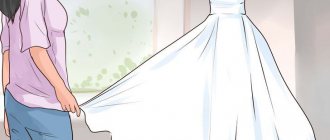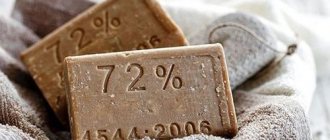What to do
Separate microfiber items from other items. If you wipe the floor with them or remove dust from surfaces, then there is probably hair, dust and other imperfections on them. If you wash them with other items, they will become even dirtier. In this case, it is better to use a separate wash for even the most unclean items.
If you are not satisfied with the stains that appear, you can use any stain remover.
Heavily soiled items should be washed in warm or hot water, while lightly soiled items can be washed in cold water. But if you decide to use dry cleaning services, you will first need to familiarize yourself with some terms and conditions for the provision of services.
The material must be dried separately from other things to avoid getting threads, hair and other particles on it. The drying process occurs very quickly.
Microfiber rags can be placed either in the washing machine or soaked with regular laundry soap under the tap.
Since such products attract debris, they should be stored away from other objects.
If there are stains on the rag, it can cause damage to smooth surfaces that you will then wipe. To ensure that it remains truly effective in the future, wash it after each use.
How to use the same microfiber for five years and thus save your investment in cleaning materials. Here are some tips for caring for your microfiber. The use of microfiber in the cleaning industry is increasing every year. And every cleaning company or entrepreneur wants to get the maximum return on their investment. One sure way to ensure a long life for microfiber is to use it according to the instructions. Often, microfiber products are packaged without instructions for use or with unclear instructions, which can lead to unexpected results.
HOW LONG CAN MICROFIBER BE USED?
Ultramicrofiber is the most durable and can be used much longer than budget microfiber or cotton rags. The life of microfiber is usually measured in number of washes, not weeks, months or years. If the packaging does not indicate the number of washes, be sure to ask the seller or manufacturer's representative for this information. Ideally, microfiber fabric should withstand this cycle - three days in use, then washed (and washed well in the process). A cycle of two days of use - wash is possible. This applies to regular, maintenance cleaning. Based on the stated life of 500 washes and a three-day cycle, the life of microfiber should last about five years. In reality, this calculation only applies to ideal usage conditions. Companies that claim a certain number of washes for their products typically test their fabrics in laboratory conditions, where the napkins are washed in six-week cycles, 24/6, using standard laundry detergents. The actual lifespan of microfiber depends on the surface for which it is used, the density of the fabric, the quality, and how the cloth is washed. Generally, the higher the microfiber density, the higher the quality.
How to properly wash and dry microfiber?
Always follow the instructions on the package. However, often the instructions are either too vague or missing. Here are some tips for proper care:
WASH:
— wash napkins at temperatures from 60°C, up to 100°C degrees for disinfection; - use an unscented detergent, without chlorine, bleach or softener; — fill the washing machine drum no more than 3/4 full with napkins; do not wash napkins in special laundry bags.
Some manufacturers write that bleach can be used to wash their fabrics. Do not use household bleach, such as sodium hypochlorite. The destruction of microfiber by chlorine is not noticeable at first glance, but you should know that washing with bleach leads to a decrease in the service life of napkins. Chlorine in general can damage almost any type of polyester, and it will harm microfiber cloths by making the lint brittle and causing it to break down easily, while compromising the integrity and reducing the usefulness of the cloth. Oxygen-containing bleaches (sodium percarbonate, peroxyhydrate) do not affect the life expectancy of the fabric and can be used.
Fragrances and softeners (rinse aids) in detergents “clog” microscopic fibers. Especially softeners that contain silicone. It coats the microfibers and interferes with their ability to clean. In addition, silicone works as an antistatic agent, reducing the ability of microfiber to attract the smallest dust particles.
DRYING:
— microfiber can be dried at air temperatures from 80°C to 120°C. If you do not gently disinfect the napkins, they can be washed at 60°C and dried at 80°C. This “soft” mode will help extend the life of microfiber. Those napkins that need to be disinfected can be safely washed at 100°C and dried with hot air at 120°C.
Wash microfiber with antimicrobial fibers or strips glued into the fabric according to the manufacturer's instructions. If such instructions are not available, use the same methods as for washing regular microfiber. Although antimicrobial fiber or antimicrobial strips kill bacteria on direct contact, these wipes still need to be properly cleaned and disinfected. Despite the fact that when cleaning with microfiber a small amount of water is used, when washing the water level should be maximum. A large amount of water is needed to rinse dirt from the space between the fibers of each napkin.
During washing, water must pass freely through the microfibers to remove debris:
— no need to overload the washing machine; — do not pack microfiber cloths in special laundry bags; - Do not wash fabrics with microfiber that leave fibers, such as cotton.
It is also important to dose the detergent correctly. Using large amounts of washing powder is one of the first places in reducing the life of fabric.
Special membrane cleaning products
Basic rules when choosing a chemical detergent :
- do not use regular crystallized powder,
- you should avoid products that contain chlorine or bleach,
- It is better to use a special product for things with a membrane.
Table of the best products for membrane jackets:
| Brand | a brief description of |
| Nikwax Tech Wash | Suitable for cleaning the membrane (without down filling). Cleans and reanimates the material. In concentrated form it is used to remove individual stains. |
| Granger's 30˚C Cleaner | Restores the water-repellent layer, destroys dirt and unpleasant odors. Suitable for any type of washing machine. Removes stains at a temperature of 30⁰C |
| Perwolle Sport Active Care 3D | Used for processing sports uniforms, does not cause damage to membrane fabric and impregnation. Does not contain phosphates. |
| Granger's Universal Spray Cleaner | The spray is sprayed onto contaminated areas (lapels, collars) from a distance of 10-15 cm. Stains easily come off when wiped with a soft cloth. |
WHERE NOT TO USE MICROFIBER?
Avoid using microfiber cloths on rough surfaces or surfaces with burrs, which can tighten and damage the fabric. On such surfaces it is better to use cotton napkins or old microfiber.
The revolutionary fiber, which has unique quality characteristics, is now actively used for household items. The fiber thickness is indicated as less than 1 denier; with a weight of 1 gram, the length of such a thread is about 9 thousand meters. Yarn made from the finest fiber containing polyester, nylon, and other polymers is called microfiber.
Products made from modern yarn have:
- incredible softness;
- light weight;
- excellent moisture-absorbing properties, allowing 7 times more liquid to be absorbed into the surface of the material, exceeding the fabric’s own weight;
- ability to absorb oily substances;
- It is wonderful to polish surfaces without leaving streaks.
Microfiber cloths are indispensable in everyday life; professionals, housewives, and car enthusiasts prefer to use them for cleaning, because they are universal and are used on surfaces made of stainless steel, plastic, and glass. Wear-resistant microfiber material, which can be washed up to 500 times, is affordable, and therefore in demand, because it is superior to natural fabrics in efficiency.
Ironing - can it be done?
Microfiber is a fabric that does not tolerate high temperatures. Even at 60 degrees, the material is easily deformed, and folds or wrinkles cannot be eliminated. To prevent damage to your favorite things, it is better to avoid using an iron.
If the items become slightly wrinkled during washing, it is better to dry them by laying the items on a soft cloth that absorbs moisture well. Straighten the towels and smooth them a little with your hands.
It happens that things are so wrinkled that you can’t do without using an iron. In such cases, use cotton napkins - place the product between them and iron at minimum temperature.
It is better to start the process from a small corner - if the fabric begins to deform under the influence of the iron, it is better not to take risks and completely abandon ironing.
Is it possible to wash microfiber and with what?
Manufacturers are happy to use microfiber to make wardrobe items, bedding, napkins and cleaning equipment. But, like any fabric, revolutionary microfiber requires proper care. Housewives, admiring the functionality of ultra-thin material, quite reasonably ask themselves the question of how to wash microfiber in order to preserve the original characteristics of napkins or large items that give comfort and coziness in the room. Proper washing of soft items that are pleasant to the touch should preserve the delicate texture of the fabric, while ridding the fibers of contamination.
The housewife must be clearly aware of how to wash microfiber, because the appearance of the product depends on the choice of detergents. In order not to spoil your favorite item and preserve its appearance and quality characteristics for a long time, you must adhere to the following rules:
- You need to wash only in warm water, not exceeding 40-60 degrees. Microfiber categorically does not tolerate extremely high temperatures.
- You cannot boil or iron napkins or towels made of ultra-thin microfibers, as this can destroy the product.
- When washing by hand, use washing powder or laundry soap.
- Artificial fibers do not retain dirt in the polyester threads, so any remaining dirt can be easily washed out. Washing does not cause much trouble even for an inexperienced housewife, because dirt of any complexity is eliminated without additional effort.
- After wrung out the product well, it is hung indoors or outdoors. Microfibers not only absorb moisture well, but also release it easily, which allows you to quickly dry things.
- You should avoid placing microfiber items next to dyeable items, because the item will certainly fade and change color.
High-quality detergents with aggressive additives will help bring microfiber products to ideal condition.
Drying rules
Microfiber linen feels great in direct sunlight. Moisture from the fabric evaporates quickly, so you need to control the process and not leave the products outside longer than necessary.
Even if you used a machine for washing, it is better not to risk the appearance of your favorite towels or bed linen and spin it manually, and then send it outside to dry.
How to dry microfiber
If drying occurs indoors, it is recommended to ensure that there are no heat sources nearby. Do not hang wet items on the radiator - this can lead to folds, wrinkles, and deformation of the fabric. It is better to hang towels or linen in a warm room.
How to wash microfiber in a washing machine correctly
Time-strapped housewives or those who do not want to wash by hand can use an automatic washing machine. Rules for safely washing microfiber in a machine:
- Considering that the fabric is voluminous, it is not recommended to load the drum as much as possible; filling it 70-80% is quite enough.
- You should study the manufacturer's information on the label, which indicates the temperature regime for washing microfiber products. Generally, 40 to 60 degrees are recommended.
- Exclude items from the drum that can stain fabric made from ultrafine fibers. The items themselves with the addition of synthetic threads do not color other items, but can easily absorb other shades into the fibers.
- It is necessary to strictly follow the manufacturer's recommended dosage of detergent.
- For heavily soiled items, it is recommended to use the pre-wash mode to achieve a good final result.
- Preference is given to the delicate washing mode.
- It is necessary to avoid conditioners when rinsing.
- You should not dry products in a machine.
By following the rules outlined above, housewives will extend the life of products made from super-durable fabric, while spending minimal effort.
Rules for washing bulky microfiber items
An increasing number of residents are seeking to diversify their wardrobe with high-quality and comfortable models made of ultra-durable and soft-touch material. But how to wash a microfiber jacket to preserve its original appearance without deforming the structure of the fabric. It is recommended to use a spacious container where the item of clothing can be conveniently placed if you decide to wash a jacket or blanket by hand. When loading a bulky item into the drum, it is better to wash it without loading the washing machine with other items.
Those who have no experience caring for newfangled fabric are puzzled by how to wash a microfiber blanket in order to maintain the softness of the fibers. It is a serious mistake to use conditioner, which is contraindicated for this texture. If conditioner was added by mistake, you will have to thoroughly rinse the items after washing in several waters.
Let's choose a remedy
Gels are most effective when cleaning microfibers. Liquid products have a gentler effect on the material, penetrate the fabric structure faster and are quickly rinsed out of it, without leaving marks or streaks. You can also wash with washing powders, but there is a high probability that the granules will not completely dissolve in water and will remain between the fibers. Use the gel or powder in the usual way:
- when machine washing, add the mixture to the tray according to the instructions;
- if the item is washed by hand, then first prepare a soap solution by dissolving the gel in water;
- Afterwards, the product is thoroughly washed until the foam is completely removed from the fibers.
When choosing a product, you also need to look at its composition. It is not recommended to wash microfiber with mixtures with a strong bleaching effect, since aggressive components destroy the soft fibrous layer. Air conditioners and rinse aids are also prohibited.
How to wash a microfiber cloth: effective methods
Synthetic cleaning equipment often requires additional effort to get it in good condition. The question is rightfully asked: is it possible to wash a microfiber cloth in a washing machine or is it better to do it by hand? The choice should be made based on the degree of contamination of the rag. Motorists or housewives cleaning their premises often hesitate between “throwing it away” or “trying to wash it”. If microfiber cloths are very dirty, how to wash them is decided taking into account the nature of the substances that affected the appearance of the cleaning equipment.
To achieve impeccable cleanliness of a durable microfiber product you need:
- Prepare a container with warm water in which to dissolve the detergent;
- Having previously washed the areas of contamination, rags, napkins, covers are loaded from the vehicle;
- leave soaked items for 8-10 hours;
- remove from the soapy solution and rinse the rags;
- if remaining stains are detected, you need to use a paste of water and soda, which is applied to the stains, and after an hour the product is washed;
- then rinse thoroughly with the addition of lemon juice, squeeze and dry the items flat.
A few important “don’ts” when washing microfiber
To summarize, it should be taken into account that the multifunctional fabric will withstand up to 500 washes. To prevent the products from losing their original appearance, you should remember that it is strictly prohibited:
- boil microfiber or immerse it in water with a temperature above 60 degrees;
- iron products made from the finest polymer fibers;
- dry items in a washing machine;
- dry on radiators;
- use aggressive bleaching agents.
No matter how you decide to wash a jacket or napkin, if you follow the recommendations of experts, you can maintain the impeccable condition of the fabric.
The revolutionary fiber, which has unique quality characteristics, is now actively used for household items. The fiber thickness is indicated as less than 1 denier; with a weight of 1 gram, the length of such a thread is about 9 thousand meters. Yarn made from the finest fiber containing polyester, nylon, and other polymers is called microfiber.
Products made from modern yarn have:
- incredible softness;
- light weight;
- excellent moisture-absorbing properties, allowing 7 times more liquid to be absorbed into the surface of the material, exceeding the fabric’s own weight;
- ability to absorb oily substances;
- It is wonderful to polish surfaces without leaving streaks.
Microfiber cloths are indispensable in everyday life; professionals, housewives, and car enthusiasts prefer to use them for cleaning, because they are universal and are used on surfaces made of stainless steel, plastic, and glass. Wear-resistant microfiber material, which can be washed up to 500 times, is affordable, and therefore in demand, because it is superior to natural fabrics in efficiency.
What kind of fabric is this and what is it afraid of?
Microfiber is woven from the finest fiber - polyester, polyamide or nylon. It is used to make bedding, towels, cleaning equipment, furniture, eyeglass wipes and car seats.
Synthetics do not tolerate hot water, ironing, bleaching and aggressive detergents. It is also not recommended to twist it too much when spinning, although the material is resistant to deformation. The fabric does not like the effects of fabric conditioner; because of it, it loses its unique properties.
For information: Due to improper care, microfiber does not tear or lose its properties instantly, but it wears out noticeably faster. If you wash the products correctly, they will last for several years.
Manufacturers usually indicate on the label how to care for the material, whether it can be machine washed or whether it is recommended to remove dirt manually. There is also information about temperature conditions.
Is it possible to wash microfiber and with what?
Manufacturers are happy to use microfiber to make wardrobe items, bedding, napkins and cleaning equipment. But, like any fabric, revolutionary microfiber requires proper care. Housewives, admiring the functionality of ultra-thin material, quite reasonably ask themselves the question of how to wash microfiber in order to preserve the original characteristics of napkins or large items that give comfort and coziness in the room. soft products that are pleasant to the touch should preserve the delicate texture of the fabric, while ridding the fibers of contamination.
The housewife must be clearly aware of how to wash microfiber, because the appearance of the product depends on the choice of detergents. In order not to spoil your favorite item and preserve its appearance and quality characteristics for a long time, you must adhere to the following rules:
- You need to wash only in warm water, not exceeding 40-60 degrees. Microfiber categorically does not tolerate extremely high temperatures.
- You cannot boil or iron napkins or towels made of ultra-thin microfibers, as this can destroy the product.
- When washing by hand, use washing powder or laundry soap.
- Artificial fibers do not retain dirt in the polyester threads, so any remaining dirt can be easily washed out. Washing does not cause much trouble even for an inexperienced housewife, because dirt of any complexity is eliminated without additional effort.
- After wrung out the product well, it is hung indoors or outdoors. Microfibers not only absorb moisture well, but also release it easily, which allows you to quickly dry things.
- You should avoid placing microfiber items next to dyeable items, because the item will certainly fade and change color.
High-quality detergents with aggressive additives will help bring microfiber products to ideal condition.
How to wash microfiber in a washing machine correctly
Time-strapped housewives or those who do not want to wash by hand can use an automatic washing machine. Rules for safely washing microfiber in a machine:
- Considering that the fabric is voluminous, it is not recommended to load the drum as much as possible; filling it 70-80% is quite enough.
- You should study the manufacturer's information on the label, which indicates the temperature regime for washing microfiber products. Generally, 40 to 60 degrees are recommended.
- Exclude items from the drum that can stain fabric made from ultrafine fibers. The items themselves with the addition of synthetic threads do not color other items, but can easily absorb other shades into the fibers.
- It is necessary to strictly follow the manufacturer's recommended dosage of detergent.
- For heavy dirt, it is recommended to use the mode, which will allow you to achieve a good final result.
- Preference is given to the delicate washing mode.
- It is necessary to avoid conditioners when rinsing.
- You should not dry products in a machine.
By following the rules outlined above, housewives will extend the life of products made from super-durable fabric, while spending minimal effort.
Rules for washing bulky microfiber items
An increasing number of residents are seeking to diversify their wardrobe with high-quality and comfortable models made of ultra-durable and soft-touch material. But how to wash a microfiber jacket to preserve its original appearance without deforming the structure of the fabric. It is recommended to use a spacious container where the item of clothing can be conveniently placed if the decision is made manually. When loading a bulky item into the drum, it is better to wash it without loading the washing machine with other items.
Those who have no experience caring for newfangled fabric are puzzled by how to wash a microfiber blanket in order to maintain the softness of the fibers. It is a serious mistake to use conditioner, which is contraindicated for this texture. If conditioner was added by mistake, you will have to thoroughly rinse the items after washing in several waters.
What washing products should I use?
An important rule that must be followed is that there should not be a lot of powder .
It's a good idea to check the label before purchasing a detergent for this fabric . For example, you should discard the powder if it contains bleaching components. It is recommended to look for packaging that states that the pH is less than 10 units . The ideal option would be to wash with powder intended for children's products.
By the way! Microfiber can be easily washed with regular laundry soap. You can grate it and add it to a bowl of water. This procedure is suitable in cases where soaking is required. Another way is to rub particularly dirty areas with a bar of soap, and then rinse the product.
How to wash a microfiber cloth: effective methods
Synthetic cleaning equipment often requires additional effort to get it in good condition. The question is justifiably asked: should a microfiber cloth be used in the washing machine or is it better to do it by hand? The choice should be made based on the degree of contamination of the rag. Motorists or housewives cleaning their premises often hesitate between “throwing it away” or “trying to wash it”. If microfiber cloths are very dirty, how to wash them is decided taking into account the nature of the substances that affected the appearance of the cleaning equipment.
To achieve impeccable cleanliness of a durable microfiber product you need:
- Prepare a container with warm water in which to dissolve the detergent;
- Having previously washed the areas of contamination, rags, napkins, covers are loaded from the vehicle;
- leave soaked items for 8-10 hours;
- remove from the soapy solution and rinse the rags;
- if remaining stains are detected, you need to use a paste of water and soda, which is applied to the stains, and after an hour the product is washed;
- then rinse thoroughly with the addition of lemon juice, squeeze and dry the items flat.
A few important “don’ts” when washing microfiber
To summarize, it should be taken into account that the multifunctional fabric will withstand up to 500 washes. To prevent the products from losing their original appearance, you should remember that it is strictly prohibited:
- boil microfiber or immerse it in water with a temperature above 60 degrees;
- iron products made from the finest polymer fibers;
- dry items in a washing machine;
- dry on radiators;
- use aggressive bleaching agents.
No matter how you decide to wash a jacket or napkin, if you follow the recommendations of experts, you can maintain the impeccable condition of the fabric.
Mops and microfiber cloths should be washed regularly in the washing machine. The recommended temperature for daily washing is 60°C. Washing at a temperature of 95°C is used for thermal disinfection, mainly in healthcare institutions. Please note that proper care of microfiber products significantly extends their service life.
- LOADING THE WASHING MACHINE
- Loading should be approximately 80% of machine capacity.
- Do not wash mops and microfiber cloths with other items.
- PREWASH
- Always wash in warm water (maximum 40°C) without using powder.
- MAIN WASH, DOSAGE
- Follow the laundry detergent dosing instructions.
- Start dosing with the recommended minimum amount of cleanser.
- If liquid detergent is used, the automatic dosing system will provide the exact amount.
- TEMPERATURE
- Most modern detergents are cleaned in water at a low temperature (60°C and below).
- Recommended temperature 60°C.
- WASHING POWDER
- Use laundry detergent for colored fabrics or with less alkalinity.
- The pH level in the cleaning solution should be of medium alkalinity (maximum 10.5).
- BLEACH / DISINFECTANT
- Bleach should only be used when disinfection is required.
- Do not use chlorine bleach.
- AIR CONDITIONER
- Do not use conditioner. It reduces the absorbency of the cloth/mop.
- SPIN
- Dry at low temperatures only (maximum 50°C).
A few of my comments on the above
.
These recommendations are written for hotels, etc. organizations that have the opportunity to wash only rags. This is more difficult in everyday life. But for example, I understand the recommendation about 80% loading of the machine as no more than 80%
. Those. When washing microfiber, do not load the machine to capacity. Do you know how I do it? I plan on washing rags for NVN. It is at NVN that I wash floors with microfiber pads. I have 6 or 7 of them. And after washing the floors, I rinse them in a bucket to remove large dirt, and wash the rest in the machine. And that’s when I collect all the rags and rags. Of course, the machine does not reach a full or even 80% load. But still, I don’t risk throwing in anything else along with these rather demanding items to wash. Moreover, I set it to the quick wash mode (for me it’s 30 minutes at 30 degrees). It seems to be washed off. Well, that’s all Vileda and I could tell about microfiber. I hope that using the knowledge gained and following the recommendations received, you will long and joyfully use a variety of microfiber products that the sophisticated imagination of manufacturers can only offer. Other posts about the tools we recommend for flyers.
We clean the dirt manually
If there is enough free time, then the fabric can be washed without the help of a washing machine. This option is much safer and more economical - you can do without unnecessary consumption of resources and minimize mechanical impact. You just need to take note of a few important nuances:
- we heat the water to 40-50 degrees (boiling is contraindicated, since microfiber quickly deforms at high temperatures and loses its original appearance);
- we select a suitable detergent (if you are washing colored clothes, then the composition should not contain aggressive bleaches);
- sort clothes by color;
- do not rub the fabric too much, as the stain quickly disappears in water (microfiber repels dirt, preventing it from penetrating deep into the material);
- squeeze out easily without twisting.
Aggressive bleaches are destructive for microfiber.
Manufacturers of multifunctional microfiber claim that the fabric can survive about 500 washes. The main thing is not to disturb the structure of the fibers with strong friction and avoid aggressive bleaching components . Remember that artificial fabric has dirt-repellent properties, so even delicate compositions quickly clean the material without prolonged soaking.
